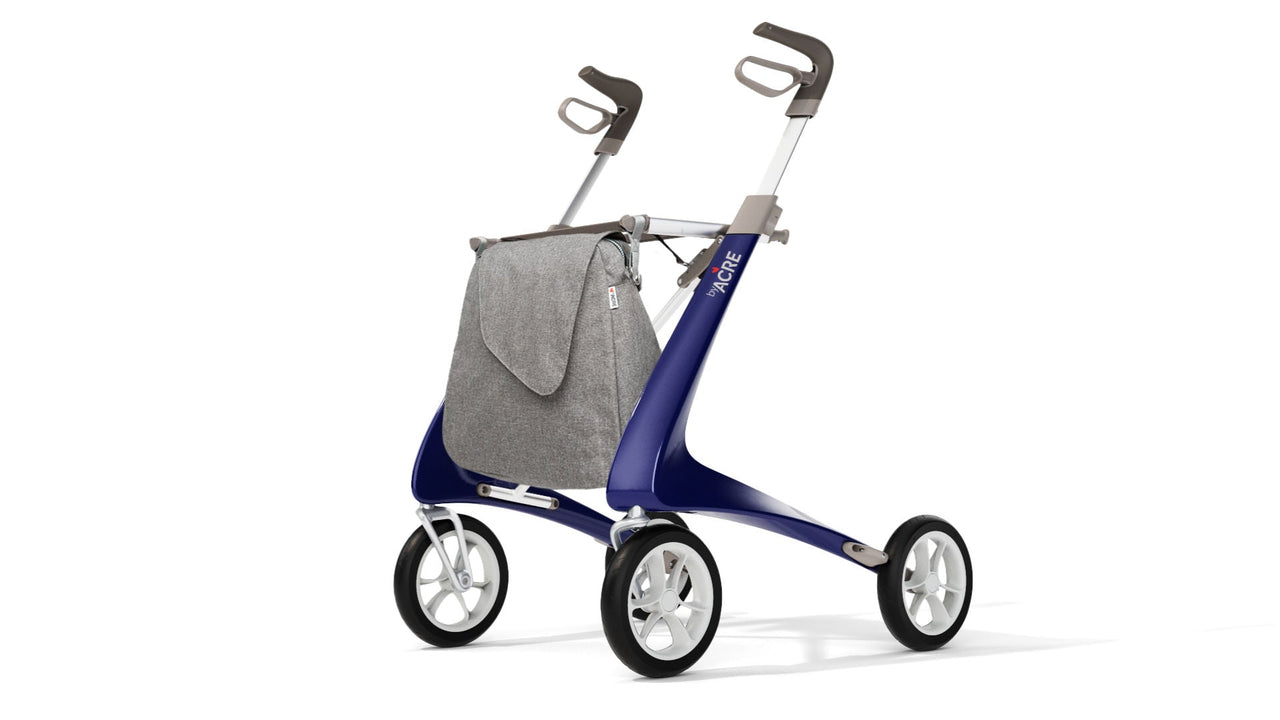
Why an NHS physiotherapist believes a byACRE rollator is more beneficial to users with mobility limitations versus the rest
“byACRE rollators will add life to your years, not just years to your life”
Having been a physiotherapist in the NHS for over 10 years I have worked closely alongside patients with a variety of co-morbidities and conditions that lead to reduced mobility, either temporarily or permanently. I prescribe mobility aids on a daily basis and I am highly trained in analysing movement. In my opinion the byACRE mobility range is head-and-shoulders above all other market products for mobility aids and I am going to tell you why.
My time spent working on wards with elderly patients has offered invaluable insight into the importance of mobility aids, rollator frames in particularly. They offer their users priceless independence that the majority of the public take for granted.
Unfortunately, due to high financial restrictions within the NHS, the choice and quality of rollators provided is extremely limited. In fact, the rollators used within the NHS have not changed since my physiotherapy training days almost 15 years ago. Medical development is advancing everyday meaning an aging population are now living longer with chronic health issues but unfortunately innovation and development of NHS mobility aids has not been reciprocated. They are low-cost mass-produced products that fail to stand the test of time.
A high-quality mobility aid can add life to your years, not just years to your life, and this is why I have been so impressed with the byACRE rollator range. Their rollators are at the cutting-edge of rollator frame technology. It is suitable for a wide range of health conditions such as osteoarthritis, rheumatoid arthritis and COPD.

I have been fortunate enough to trial a byACRE Carbon Ultralight Rollator with one of my patients Rose. I had been working on outdoor mobility with Rose since her discharge from hospital three months ago due to an infection and a fall at home. Whilst indoor mobility had returned to base-line, outdoor mobility was proving a tougher nut to crack. Prior to her fall Rose would regularly leave the house to visit her local church and local shops with use of a walking stick. She had family nearby who would take her out for her weekly shop but unfortunately since the fall it had become a challenge to get Rose back outdoors again. Her confidence had dramatically reduced and she was refusing any outdoor activities with the mindset that she would prefer to stay indoors for the foreseeable future. Relatives, church friends and myself would visit to help encourage Rose and build her confidence back-up but nothing seemed to be working. That was until we trialled the byACRE Carbon Ultralight Rollator.
My first thoughts when seeing the Ultralight for the first time was that it was very light and streamline in appearance. Rose stated that she felt safe and secure on first use. The frame is made from carbon fibre material that provides sturdiness yet maintains its lightweight property, enabling it to be easily lifted up over a step or picked-up and placed in to a car boot. It was a far cry from the cumbersome and bulky rollators and zimmer frames I am familiar with in the NHS.
One of the main benefits of a lighter frame is that the user will exert less energy whilst using the rollator compared with other bulkier and heavier products. Heart-rate and breathing-rate will stay at a lower level for longer periods, reducing fatigue and allowing the user to spend longer periods on their feet without getting tired. This has great cardiovascular benefits and helps build muscular endurance along with driving neural pathways to develop greater balance and proprioceptive skills (Castamanga, 2019). It is also great for bone health and bone density which unfortunately reduces naturally with age, increasing the risk of a bone injury from a fall (Thies, 2023). The physiological benefits of using a lighter frame like this are invaluable.

An impressive aspect of the frame from an ergonomics point of view were the backwards handles. They help facilitate an upright posture which was perfect for Rose who is slightly kyphotic, meaning she is rounded in her mid and upper spine. With other frames she would push them too far ahead of herself as her upper body naturally leant forward, leaving her feet dangerously behind the frame. This unfortunately would increase her risk of falls as she reached forward outside her base of support. The backwards handles kept Rose in an upright position and maintained a safe-distance for her from the frame, allowing her to feel safe and well-balanced. She had a fantastic up-right posture when using the frame which was something we had been working on for months… this frame facilitated it in seconds!
The handles and seat were height-adjustable and easy to configure. The built-in seat was a good size and easy to use and fold up. Rose liked the fact she could rest her arms on the handles when sitting which made it very comfortable and helped her sit up tall instead of slumping forward. The seat fitted neatly into the frame when not in use and did not take away from the streamline appearance of the frame.
Rose is now leaving her house independently with confidence on a daily basis. She is able to visit her friends and family regularly rather than them always having to visit her.
The byACRE has given Rose a new lease of life. If you are looking to improve your outdoor mobility or just wish to upgrade your frame to a newer, more efficient model, the Ultralight is a great option. It is easy to handle, provides great support, promotes excellent posture and is easy on the eye.
Further Reading
Want to read more about the amazing features of the Ultraight?
About the Author

Joshua Hawksworth
Joshua is an Advanced Practice Physiotherapist working in the NHS in London, England. He also has experience working in both the private and sporting sectors. He has a special interest in treating and managing musculoskeletal conditions including lower back pain and osteoarthritis. He holds a Master’s degree in Sports Medicine along with qualifications in acupuncture, non-medical prescribing and injection therapy.

